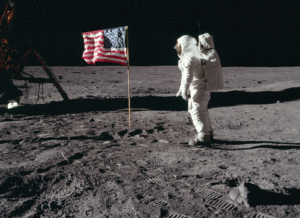By DAVE MAXWELL
Moapa Valley Progress

Do you recall where you were when Apollo 11 landed on the Moon and Neil Armstrong took that historic step?
Maybe you do. Maybe you were not even born yet.
On Saturday, July 20, the world marks the 50th anniversary of that event.
This remarkable achievement was most definitely the fulfillment of an age-old dream: that man would someday stand on the surface of the moon. It was science-fiction come true.
Since the early part of the 20th century, scientific technology had been taking numerous ideas from science-fiction writers at an alarming rate. The famous French author Jules Verne wrote of such a story in his 1865 novel From the Earth to the Moon. English author H.G. Wells published a similar series of articles entitled The First Men in the Moon, between 1900-1901. All of these things brought a fascination for exploration and discovery of space; and specifically our nearest celestial body, the Moon.
By the 1960s, the United States had become locked in the Cold War-fueled space race with the Soviet Union. The Russians had been quick off the blocks. They had stunned the world when they successfully launched a satellite into orbit around the earth. On Oct. 4, 1957, Sputnik was put into space 588 miles above the earth. It made one rotation every 96 minutes and could be seen with the naked eye at night streaking quickly across the sky. I can remember seeing that a time or two.
Sputnik greatly hurt the public pride of the United States because we were not the first to do it. Russia: 1 U.S.: 0.
Then in April 1961, the Soviet Union scored another big triumph. They were first to put a man into space. Col. Yuri Gagarin made one orbit before returning to earth. Russia: 2 U.S.: 0.
This spurred the U.S. to ramp things up. President John Kennedy, new to the Oval Office, pledged $25 billion to boost U.S. technology. The resulting program became an assembly line producer of made-in-America heroes. After many years of taking information and ideas from science-fiction, scientists were now putting all those ideas to even greater use.
Kennedy pledged that the U.S. would put a man on the moon and return him safely before the end of the 1960s.
Sadly, Kennedy didn’t live to see the dream realized. But millions of others worldwide watched as Apollo 11 launched from the Kennedy Space Center in Florida on July 16.
Apollo 11 included U.S. Astronauts Buzz Aldrin and Neil Armstrong in the Lunar landing module. They touched down on the Moon at 1:17 p.m. PDT on July 20.
Upon touching down on the Moon’s surface, Armstrong radioed back to Mission Control in Houston, “Tranquility base here. The Eagle has landed.”
About six hours later Armstrong went out of the lunar module, climbed slowly down the ladder and stepped onto the surface of the Moon.
“That’s one small step for man, one giant leap for mankind,” Armstrong said.
And where were you? I remember being at home with my mother and sister, watching the event being shown on live TV while also standing on the front porch of the house and looking up at the Moon. Of course, I was not fully able the grasp the totality of the incredible event taking place before me at the same time. None of us were.
Aldrin later joined Armstrong on the Moon. The two walked around for about two-and-a-half hours, sometimes looking like they were bounding as they were getting used to the Moon’s lighter gravity, about six times less than on Earth. They even planted an American flag and saluted.
The astronauts collected about 47 pounds of lunar rocks and other materials to bring back with them. Every traveler likes to get a souvenir.
Then the two men blasted off in the return vehicle to join Michael Collins who had been orbiting the Moon alone in the main Apollo ship Columbia. All three made the return trip back to Earth, fulfilling Kennedy’s 1961 pledge.
Five additional Moon landings would follow but only for three more years. All in all, a dozen astronauts would set foot there. Three astronauts have gone twice, and safely returned home.
But there was less fascination as America was increasingly being wrapped up in difficult times on good ol’ Earth: the Vietnam War in particular.
The last manned landing was in Dec. 1972.
Someone said, “After we discovered that the Moon was not made of green cheese, we haven’t been back since.”
July 20, 1969. What sort of a day was it? A day like all days, filled with those events that alter and illuminate our times.
Dave Maxwell resides in Pahranagat Valley, Nevada and is a sports reporter for the Lincoln County Record.










